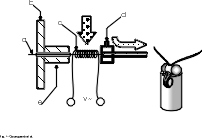
Response sample (58315 bytes)
We designed a thermal modulator that improves electrophysiological responses from insect olfactory receptors eluted from a gas chromatograph (GC). GC are very useful to separate chemical compounds from within a blend, because when you play with the temperature of the oven, the pressure of a carrier gas in the column and the phase of the column, the compounds are usually nicely separated according to their affinity to the phase. If you replace the physical detector usually used (like an FID detector), by an insect antenna, you will be able to record an electrical signal from this antenna when its olfactory receptors are stimulated by the eluted compounds. It is therefore possible to identify within a blend, the chemicals which are detected the most, and which presumably contribute the most to the identification of the total blend. Actually, most GC-EAD systems (EAD is meant for electroantennography detection) use a split placed at the end of the column, so that one part of the effluent is directed to an FID and the other one is diverted towards an insect antenna.
While this system works very well for pheromones, it is notoriously more difficult to get clear responses from plant blends, possibly because the antennal receptors are less specialized and in lesser numbers than pheromonal receptors. If one looks more carefully at a GC trace, it appears that a GC peak is eluted during 5 to 10 seconds and that its concentration changes only gradually, especially if one considers that olfactory receptors respond to the logarithm of the concentration. In that perspective, chemicals eluted from a GC are not presented in a way that is suitable to elicit a clear electrophysiological response because (1) olfactory receptors tend to adapt quickly to odors within an environment and (2) they are not designed to encode concentration but rather to signal quick changes in concentrations of chemicals.
Using a thermal modulator will chop the chemical signal into consecutive odor pulses, which has 2 advantages:
This project was developed in our laboratory, the frame of a collaboration with Jan van der Pers (Syntech, NL) and Lester Wadhams. We have evaluated this approach on the perception of pheromonal compounds from a Lepidoptera (Spodoptera littoralis). People who participated to this project are: Sandrine Gouinguené (former student in a D.E.A. of Analytical Chemistry) and Isabelle de Cruz (INRA Phytopharmacie).
Our thermal modulator was designed with 2 elements. Cool air was flushed continuously over a 2 cm length of exposed column (fig. 1). A resistive wire, coiled over this column, was periodically heated thus desorbing molecules adsorbed during the previous cold period. Cool and heat periods were alterned regularly (0.8 s heat / 2.2. s cold) thus sampling the chemical effluent. The electrophysiological response was improved, both in terms of threshold detection and of reliability of the responses.
 |
|
| Design of the system (49215 bytes) | Response sample (58315 bytes) |
If you wish more infos about this method, please read the following paper:
Gouinguené S., de Cruz I., van der Pers J., Wadhams L., Marion-Poll F. (1998) A new method to improve olfactory responses to GC effluents. Chemical Senses 23: 647-652.
return to home page; last modifications: 19 janv. 2014.